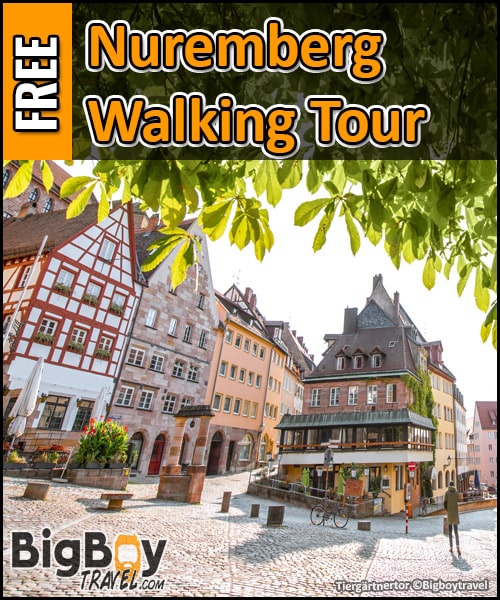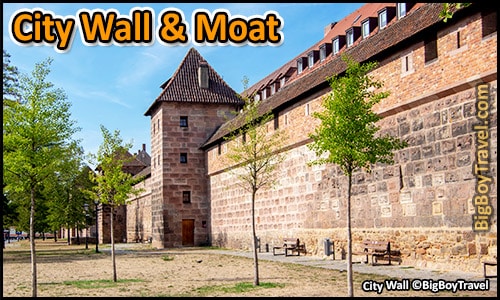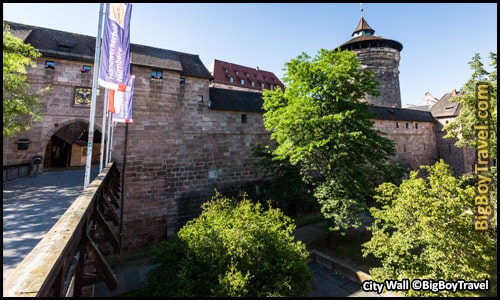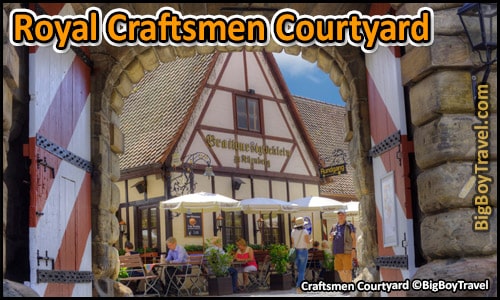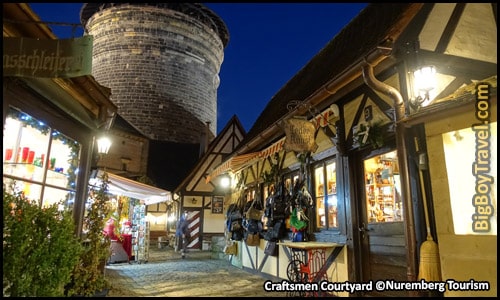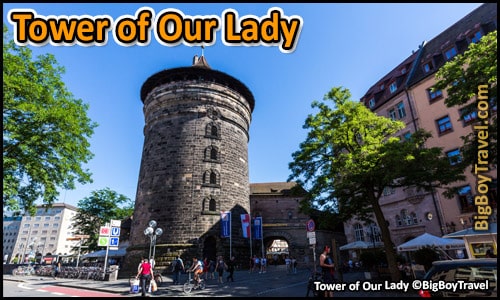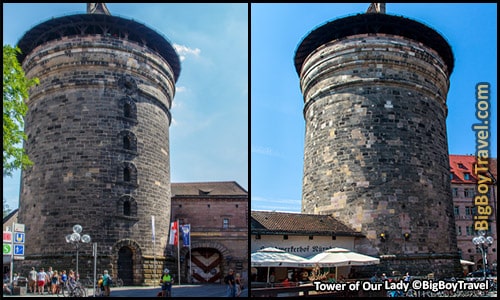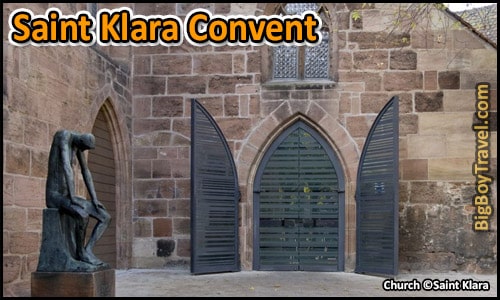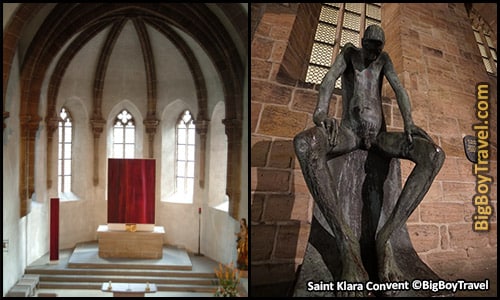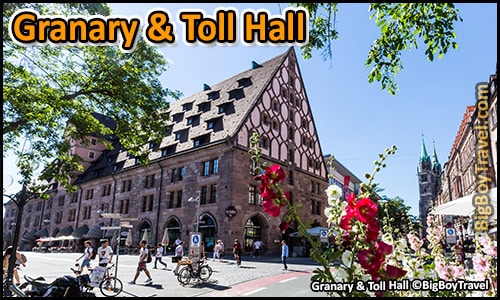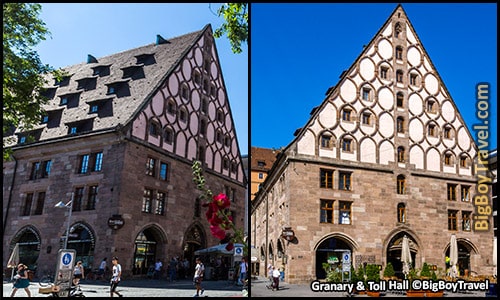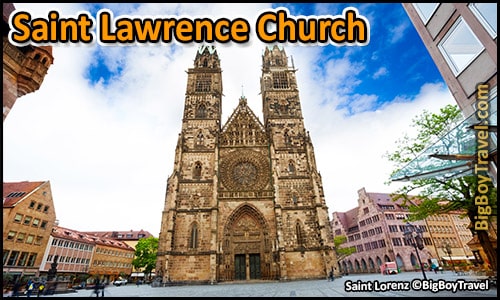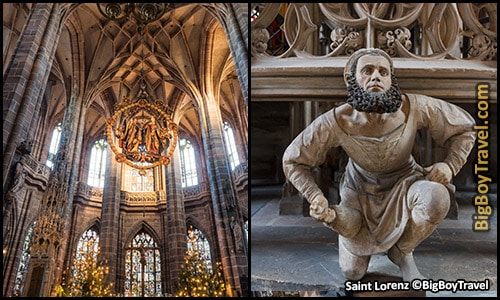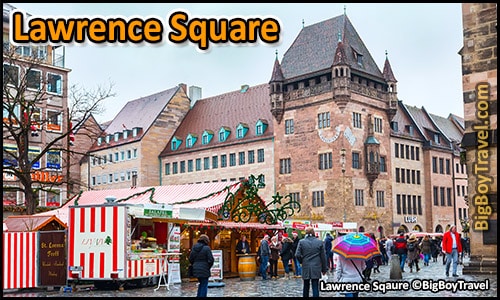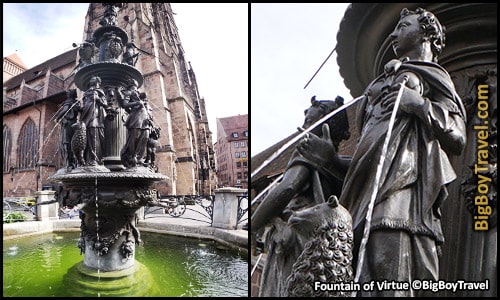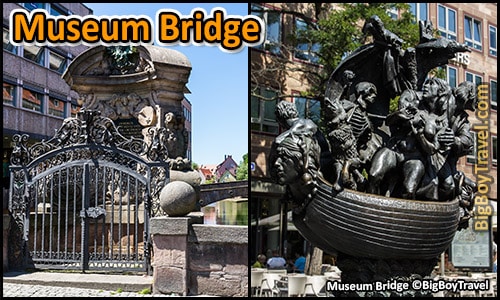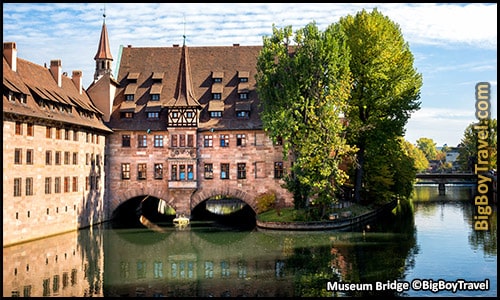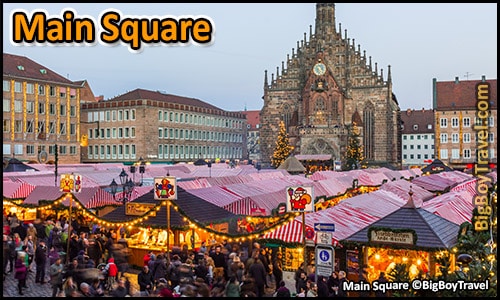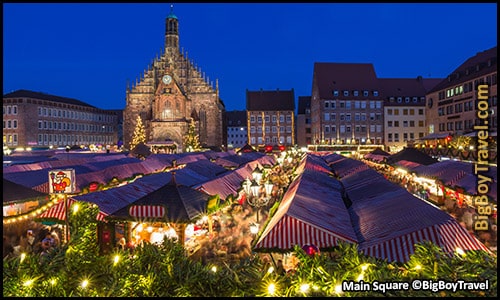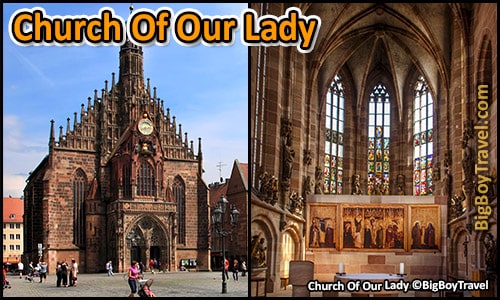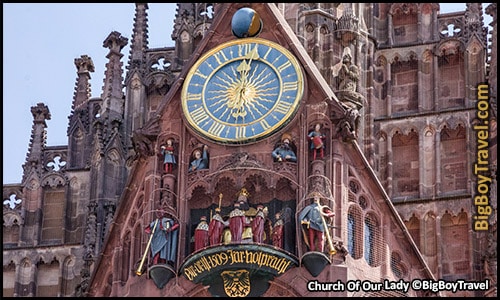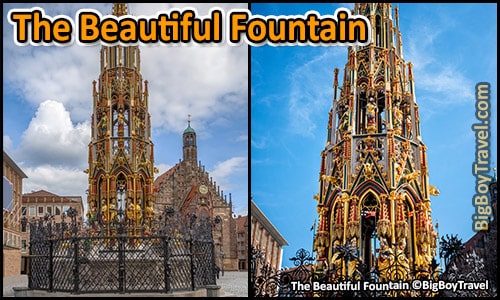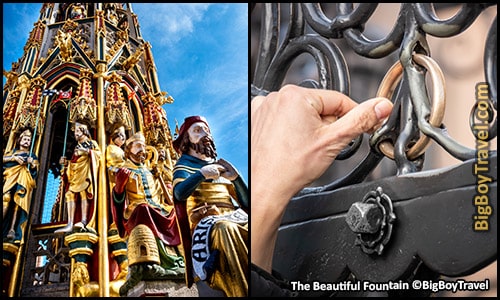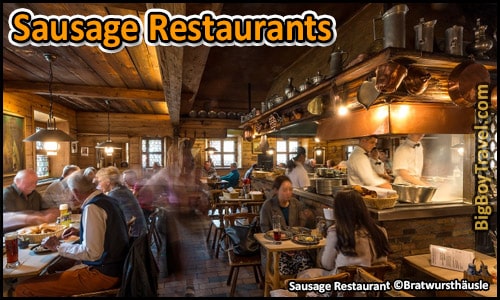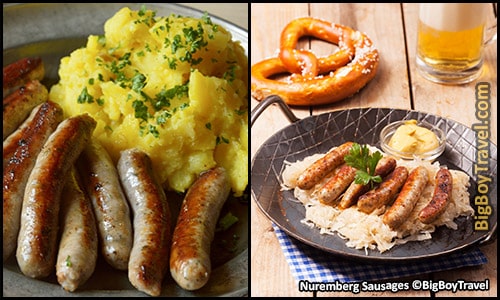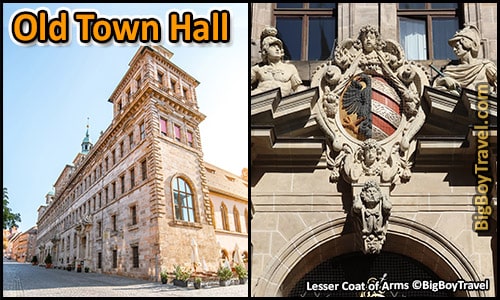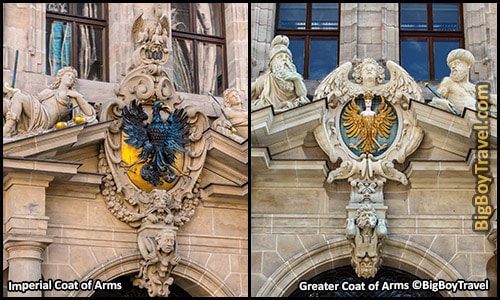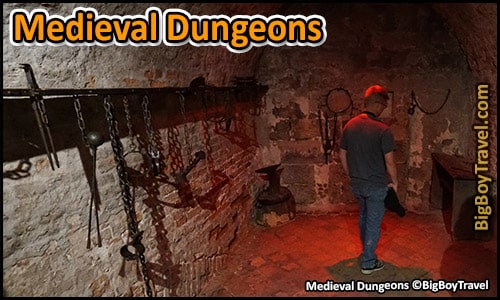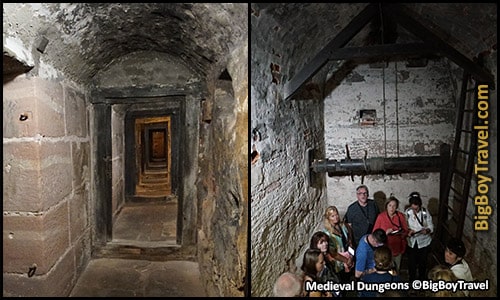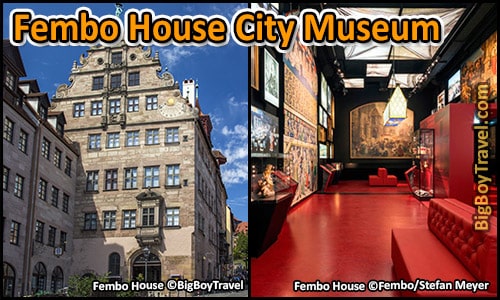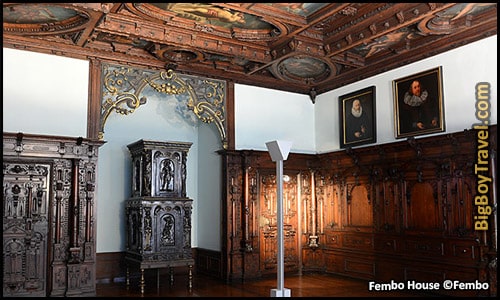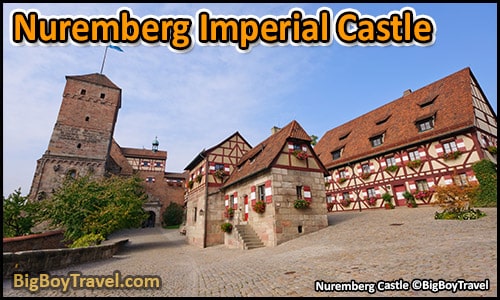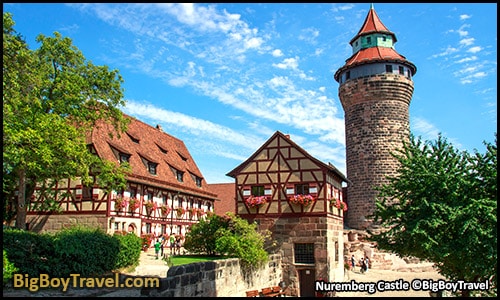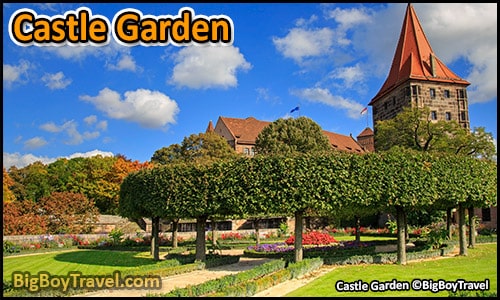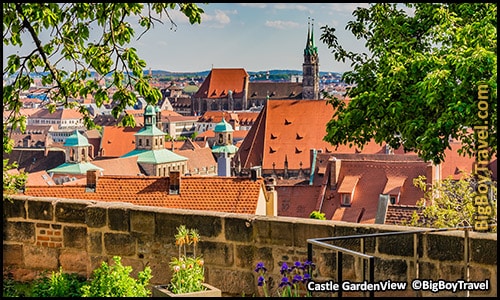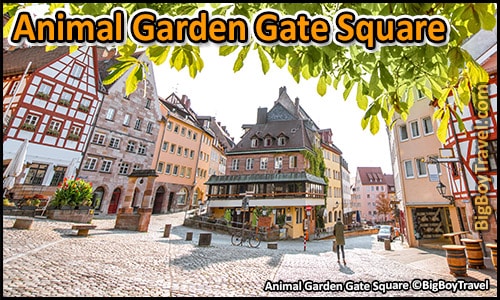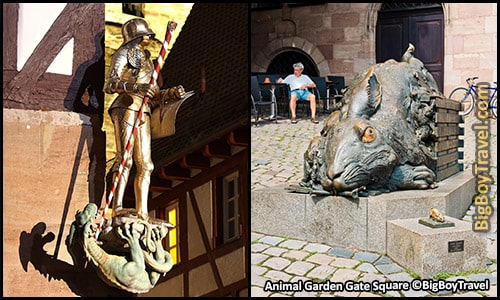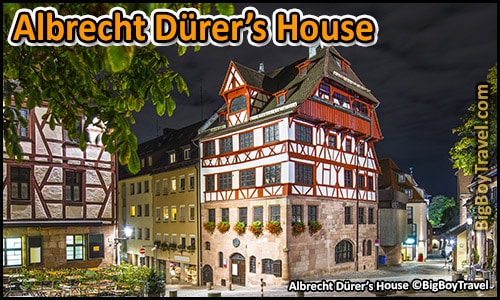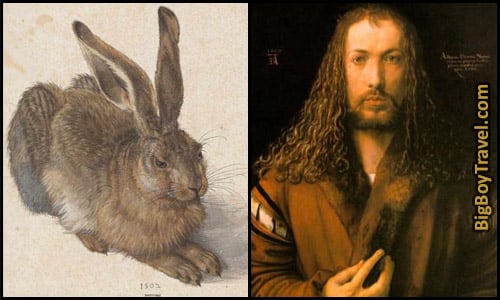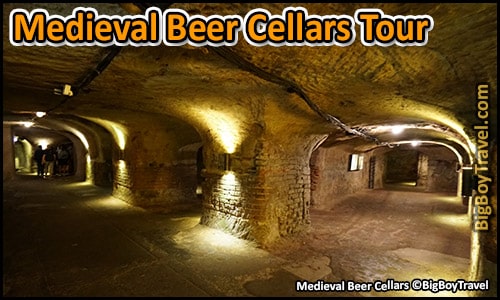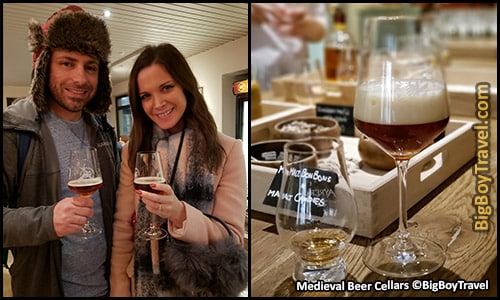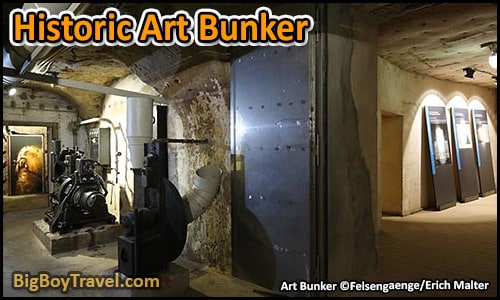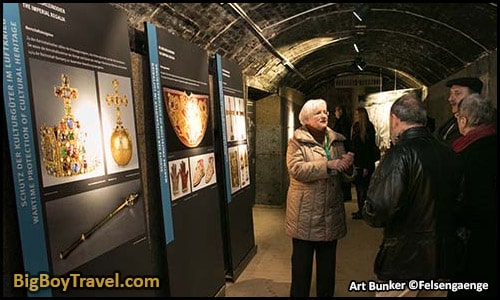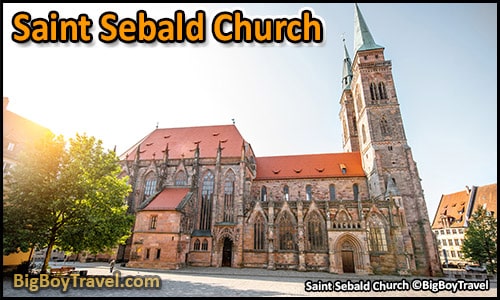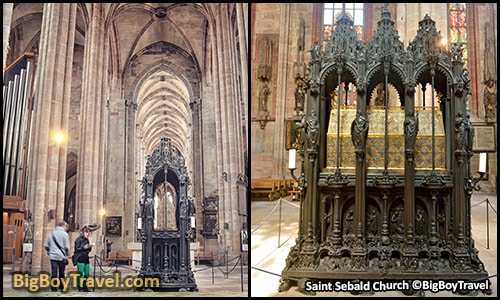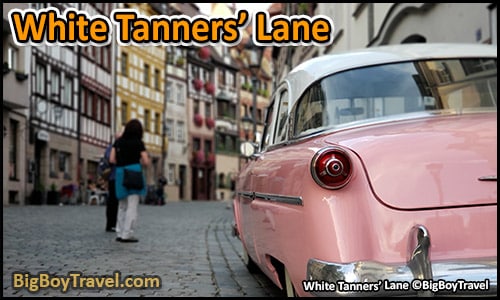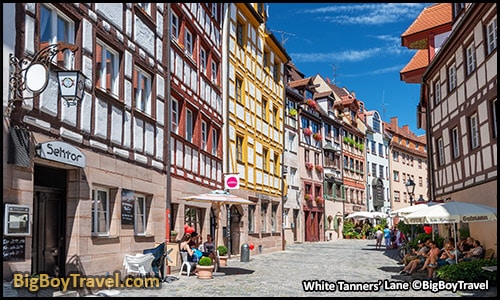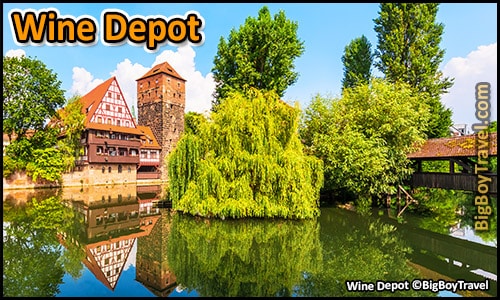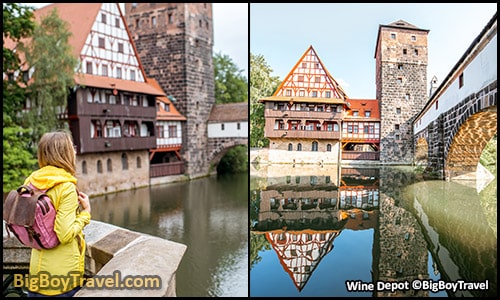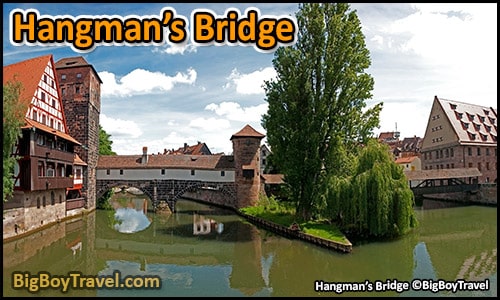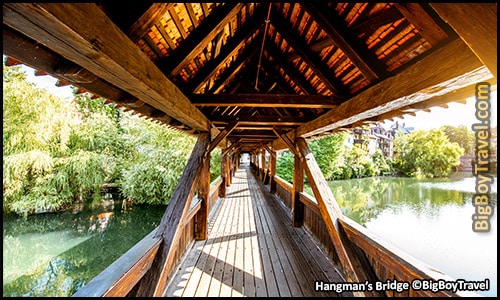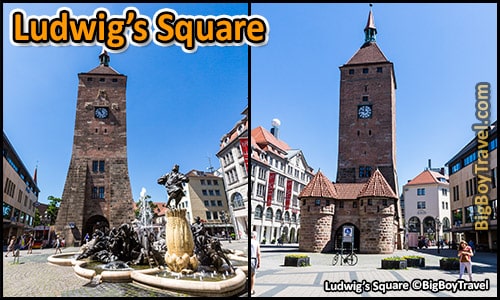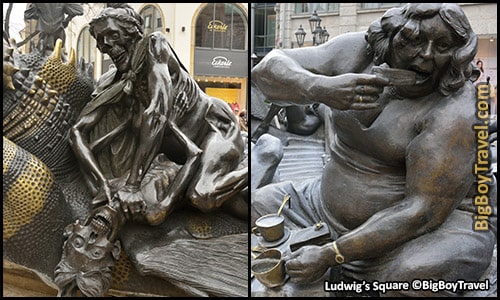Free Nuremberg Walking Tour:
Walking Tour Location: Old Town Nuremberg (Altstadt)
Cost: Free, Self-Guided (Museum costs listed below)
Style: Do-It-Yourself Walking Tour (Self Guided)
Start: Nuremberg Train Station (Hauptbahnhof)
End: White Tower Subway Stop (Weißer Turm)
Walking Distance: 2.3 Miles
Time: 2 Hours for Walk (with attractions 6 hours)
Fun Scale: 9.5 out of 10
Old Town Nuremberg Overview:
Being so close to both Munich and Rothenburg, Nuremberg is sometimes the forgetten man in the middle, but it is a true delight to visit. Once one of the mightiest medieval cities in Europe, Nuremberg was 90% ruined by ww2 bombings but has been tastefully rebuilt. The core of any visit will be Old Town Nuremberg which is still squeezed inside an impressive Medieval wall (largely rebuilt) and leads up to Nuremberg’s Imperial Castle. This famous castle shaped Old Town Nuremberg as it was the pseudo-capital and seat for the Holy Roman Empire during the Middle Ages.
Divided in half by the Pegnitz River, Old Town Nuremberg is filled with half-timbered homes and has a dense collection of huge churches. The abunance of impressive churches is mainly because Nuremberg was actually seperate towns on each side of the river until it was unified in 1320. This previous division means that there are a lot of hidden gems to find during this free Nuremberg walking tour. There are the big highlights like the churches, castle, and artist Albrecht Dürer’s house, but also underground bunkers and beer cellars. From our numerous visits to this wonderful city, our free self-guided walking tour will take you to all of the can’t miss attractions around Old Town Nuremberg.
1. Nürnberg City Wall & Moat (Stadtmauer):
About The Nürnberg City Wall: The village of Nuremberg had some very rapid expansion in the Middle Ages and grew quite powerful thanks in large part to its wonderful network of defensive city walls, towers, and moats. These defenses helped Nuremberg to never be taken by military force for almost 1,000 years until the Americas liberated the city during WW2 in 1945.
The fortifications in Nuremberg were started in the 11th Century as they began to circle independent settlements on each side of the river. The wall took its current 3-mile-long (5km) form long form (80% still standing/rebuilt) when both sides of the river were officially joined into one town in 1320. By 1452 the layout of the wall with a vast 40-feet-deep (12 meters) and up to 65-feet-wide (20 meters) moat was complete with many of the large towers added in the 1500s. While 90% of Nuremberg was damaged by bombings in WW2, the restoration of the city walls, towers, and the moat has been done amazingly well thanks to detailed pre-WW2 photography.
From the main train station, the first thing you see on this free Nuremberg walking tour is the Southeast corner of the Medieval city wall across the street. The traffic in front of the station can be quite busy, but you can take the underground passage inside to avoid the cars which puts you directly exits into the dry moat. We actually prefer to navigate the bustling crosswalks as taking the small drawbridge over the moat as you enter old town Nuremberg feels amazing. The elevated footbridge is also the best place to get some perspective on the scale of the impressive moat before entering the Women’s Gate (Frauentor) adorned with the Black Eagle Imperial Coats of Arms. On your return to the station at the end of this Nuremberg walking tour, feel free to take the underground passage.
2. Royal Craftsmen Courtyard (Handwerkerhof):
About The Royal Craftsmen Courtyard: As you cross the dry moat and enter Nuremberg’s city wall, you reach the compact Roayl Craftsmen Courtyard. This irregular-shaped square was created inside the former armory’s gun yard (waffenhof) in 1971 to celebrate the 500th anniversary of local artist Albrecht Durer’s birthday. The tiny shop houses were only meant to be temporary but because the experience was so popular they kept it. This delightful courtyard feels like a year-round Christmas market where you can see goldsmiths, doll makers, glass cutters, leather workers, gingerbread-makers, and potters hand-creating souvenirs you can buy.
3. Tower of Our Lady (Frauentorturm):
About The Tower of Our Lady: At the end of the Handcrafters Courtyard, is the round Tower of Our Lady which was as one of 160 watchtowers in town during Nuremberg’s peak power. This important tower served as the gateway and toll stop in Medieval times for all visitors from the South (Regensburg & Munich) entering Nuremberg. While there are a number of watchtowers and wall sections on our free Nuremberg walking tour, the Tower of Our Lady is our favorite in town outside of towers at the Imperial Castle.
With a 4 color alphabet combo system for referencing the towers along the wall, this was originally called Blue-Q (Blau-Q). This coded naming system better helped the city react to attacks and fires as some of the towers had numerous nicknames as the wall expanded.
After the train station opened an automobile bridge into town was opened next to the tower called The King’s Gate (Königstor) in 1853, but traffic got so congested that they had to abandon it. Since the subway opened in 1988 the handy underground King’s Gate Passage below the Tower of Our Lady has given better direct access to the station.
4. Saint Klara Convent:
About Saint Klara Convent: The historic Saint Klara Convent (Poor Claire’s) operated from 1230 until 1574 when it was closed during the Reformation. The position of the convent helped it thrive as it sat just outside the original city wall boundary next to an important gate known as the Silver Tower. As the city wall expanded outward to its current form in the 1400s, the Catholic convent also grew, but the order of local Dominican nuns was disbanded when the city turned it into a Protestant chapel in 1574.
While most of the original convent was torn down in 1899, the church (consecrated in 1274) and part of the cemetery still survive today. Restorations after WW2 have saved much of the original vaulted rib ceiling above the altar and the church’s Romanesque archway entrance dating to 1270. During the post-war restorations, they found the tomb of influential abbess Caritas Pirckheimer (died 1530) and other artifacts. The church did briefly turn Catholic again when Nuremberg was annexed into Bavaria in 1806 but since the 1990s has been serving a wide range of religious groups and events.
5. Granary & Toll Hall (Mauthalle):
About Toll Hall: The massive Medieval warehouse was built in 1500 to store grain for the citizens of Nuremberg in cases of times of crisis. At 275-feet-long (84 meters), 65-feet-wide (20 meters), and 95-feet-tall (29 meters) this was by far the largest of 12 granaries built by the Free Imperial City of Nuremberg. Prior to the grainy hall, this was the location of the original Inner Women’s Gate (Inneres Frauentor) until the city wall had its last expansion outward in 1498.
From 1571 onward, the city’s customs house and municipal scales were located in the ground floor of the granary hall building. Incoming goods from all over the world were checked and universally weighed here. This regulation of incoming commerce gave the hall its official name of name Toll Hall (Mauthall).
In Medieval times, the Herrenkeller Beer Hall was located in the vaulted cellars. During WW2, the warehouse was bombed three times from 1943-45 with the first one burning the roof and the last one burning the half the building down requiring a ton of repair. Since 1994 a brewery has returned to the cellars called Barfüßer.
6. Saint Lawrence Church (Sankt Lorenzkirche):
About Saint Lawrence Church: The humungous, twin-towered Saint Lawrence Church (Sankt Lorenzkirche) is one of the three most important churches in Nuremberg and is a must visit on this free walking tour. The church began as a three-aisled basilica in 1250 and was the city-parish for the Lorenz neighborhood laying on the South side of the River. From 1439-1477, Saint Lawrence was rebuilt with a Gothic-style nave and choir as the church grew. In 1525 it became one of the first parishes in Germany to turn to Protestant during the Reformation.
The massive scale of Saint Lawrence Church can only be realized as you back up far from the Western facing front facade. From a good distance, you can see the full height of the mighty dual bell towers which stand at 80 & 81 meters tall (262 & 265 feet). The Romanesque-style towers (like Nuremburg’s Saint Sebald Church) were modeled after Bamberg Cathedral and the oldest of the 16 surviving church bells were cast in the 1300s. Make sure to inspect the 30-foot-wide (9 meters) indented rose window and carved front portal depicting the Passion of Christ before entering the church.
While much of the bare stone interior of Saint Lawrence Church had to be repaired after WW2, much of the Gothic elements and numerous pieces of religious artwork were preserved. One of the most stunning elements are the Gothic stone ribs supporting the high vaulted ceiling as you enter the nave. The ceiling gets even more impressive as you work toward the main altar and get surrounded by Medieval stained glass windows.
The large hanging pendant near the main altar of the church is called the Angelic Salutation and was gorgeously carved out of limewood in 1518. The painted pendant shows the Archangel Gabriel telling the Virgin Mary that she carry the baby of God (known as the Annunciation) which is ringed with scenes from Mary’s life. What is especially unique on the piece is that you can both the front and back side of the figures in great detail which enhances the 3D effect.
Below the Angelic Salutation pendant, the real gem of Saint Lawrence Church is the 66-foot-tall (20 meters) tabernacle. Carved out of sandstone from 1493-1496, the tabernacle not only holds the Holy Sacraments (wine & bread) for church services but also shows scenes from the Passion of Christ in elaborate detail. As you follow the multi-story tall scenes, pay attention to the bearded figure at the base which is a self-portrait of the tabernacle’s sculptor Adam Kraft.
7. Lawrence Square (Lorenzerplatz):
About Saint Lawrence Square: As you leave the Saint Lawrence Church, the large square surrounding it is also worth inspecting further. The most predominant feature of the square after the church itself is the Gothic-style Nassauer Haus which is the last surviving medieval tower house in Nuremberg. In the Middle Ages, urban tower houses littered Medieval villages as they provided both a defensive vertical retreat during invasions while also serving as a status symbol for wealthy families.
The Nassauer Haus built here as early as the 1100s, but the nickname is an erroneous reference to King Adolf von Nassau. We love the corner princess-like bay windows and the timeless sundial on the stately Medieval home. There are also detailed carvings below the roofline showing the of the coats of arms for the Holy Roman Empire, the Pope, variois Electoral Princes, and the city of Nürnberg. The tower house is so beautiful that in 1431, King Sigismund mortgaged his crown to own the property. At the time he was the King of Germany, Hungary, and Bohemia while on his way to becoming the Holy Roman Emperor in 1433.
Also in Saint Lawrence Square is the playful Fountain of Virtue (Tugendbrunnen) which was cast from 1584-1589. This unique fountain is capped by a blindfolded Justice holding her scales and sword while supported by the 6 virtues spouting water from their bare breasts. As you circle the emerald green water clockwise you’ll see Faith (with a cross & cup), Love (with two children), Hope (with an anchor), Charity (with a lion), Temperance (with a water jug), and Patience (with a lamb). The Fountain of Virtue is covered during the Winter, but for most of the year you can admire it from every angle. There is also a second tiny fountain along the church called the Devil’s Fountain (Teufelsbrünnlein) showing a dragon and the devil taking a schoolboy.
8. Museum Bridge (Museumsbrücke):
About Museum Bridge: As you follow the natural flow of foot traffic to the North you will reach the Museum Bridge which was the first permanent crossing over the Pegnitz River when it was built in 1200. It was originally called the Barefoot Bridge (Barfüßerbrücke) as it connected to the Franciscan monastery with the city and was then renamed the King’s Bridge (Königsbrücke) after taking its double arch form in 1700. Side panels show the coat of arms for the places Emperor Leopold I ruled in the day including the Holy Roman Empire, Hungary, and Bohemia, and Nuremberg. The current name of Museum Bridge is a little confusing, but it comes from the high society Museum Club which built reading and social meeting house here (Königstraße #1) in 1810.
After being damaged in WW2 and rebuilt in 1954, the Museum Bridge offers excellent views of the former Holy Ghost Hospital (Heilig-Geist-Spital) as you cross the river. Beautifully reflecting on the water, the hospital was built in 1332 through donations by money lender Konrad Gross who was the richest man in town. Gross sponsored a number of large civic projects as soul devices (Seelgerät) to help buy his way into heaven and salvation through generous charity. His table style tomb with 8 mourning statues can be seen inside the stunning Crucifixion Court (Kreuzigungshof) which also spans the river connects to the Eastside of the Holy Ghost Hospital.
The former hospital is most famous for being the place where the Imperial Jewels and crown of the Holy Roman Emperor were stored from 1424 to 1796 before they were moved to Vienna. Having been damaged in WW2, the rebuilt Holy Ghost Hospital now serves as one of the best restaurants in Nuremberg. The cozy interior is wonderful and it is great that they stayed true to the original design which spans the water and connects to a small island in the middle of the Pegnitz River. Along with the Wine Depot later on this free Nuremberg walking tour, the Holy Ghost Hospital is one of the most beautiful riverfront buildings in town.
While on the Museum Bridge, make sure to look at the Butchers’ Bridge (Fleischbrücke) just to the West which was built in 1335. From the side, you can see the delightful curves of the arches which were meant to mimic the Rialto Bridge in Venice, Italy. This elegant version of the Butchers’ Bridge was completed in 1598, survived WW2 undamaged, and is adorned with a huge stone ox from 1599 at the sit of the former meat house.
At the end of the Museum Bridge is the dramatic Ship of Fools Fountain (Narrenschiffbrunnen) cast in all black and installed here in 1990. You’ll find figures of Adam & Eve, Cain as a child, and Death crammed into a small ship. The figures are meant to be representations of the woodcuts of Albrecht Dürer made in the 1500s from the moral satire novel The Ship of Fools written by Sebastian Brant in 1497 about violence and threats to the environment.
Restaurant Hours: Open daily at 11:30am with hot meals until 11:00pm.
9. Main Square (Hauptmarkt):
About The Main Square: Nuremberg’s mega-sized Mega Square is has a number of impressive sights and is best known as the home of the largest Christmas market in Europe. In the 1100s this lowland area along the river was settled by Jewish people who had been expelled from Germany’s Rhineland. The neighborhood grew from a swampy marsh to a thriving Jewish community wedged between the two walled sections of Nuremberg located on each side of the river.
After all of Nuremberg was united under one system of walls in 1320 the centrally located Jewish neighborhood started to get chipped away by local authorities. The final blow came when the Ghetto was officially seized under orders from Emperor Charles IV in 1349. Nearly 600 Jewish residents were burned alive in religious persecution (Plague Pogrom) on December 5th and the ghetto was demolished in favor of a new vast market square. Just fifty-one years earlier in 1298, over 700 local Jews had been killed here in a similar fashion (Rindfleisch Pogrom) in a rampage which saw 20,000 Jewish people across 146 towns. After these two rounds of persecution, the local Jewish community was essentially gone.
The new square over the former Jewish neighborhood was originally called the Green Market (Grüner Markt). From Medieval times through 1895, the square was ringed with a horse-shaped colonnade of permanent market stalls (verschandelung). Starting in 1495 during the Imperial Days Festival (Reichstag) Medieval tournaments once took place in the square.
While there are no more tournaments, today the Main Square still has a weekly market in the Spring through Fall. The biggest event however is the Nuremberg Christmas Market (Nürnberger Christkindlesmarkt) which is the largest in Europe fills the entire 5,000 square meter square. The Christmas Market has been going on here since the 1600s.
Today, the Nuremberg Christmas Market has over 2 million visitors a year and 200 wooden stalls with all of the regions of Germany plus many different foreign countries having their own sections. The market spills out onto the neighboring squares including the children’s market with rides, games, and activities in Hans-Sachs-Platz. Among the most famous items to buy at the market are Nuremberg Sausages (Rostbratwürste), mulled wine (Glühwein) in souvenir mugs, and little men made out of dried plums (Zwetschgenmännla).
10. Church Of Our Lady (Frauenkirche):
About The Church Of Our Lady: As the focal point of Nuremberg’s Main Square, the beautiful Church Of Our Lady (Frauenkirche) was the first Gothic hall church in Franconia. The church was built from 1352 to 1362 on the foundations of a former Jewish synagogue (built in 1296) which was ruined during local religious persecutions. Known as the Pogrom of 1349, the Jewish community near the synagogue were all either murdered or expelled from Nuremberg after being used as scapegoats for a recent plague.
As the impressive Church Of Our Lady was nearing completion in 1361, the imperial regalia of the Holy Roman Empire were put on public display here for the very first time. This rare public view of the crown and regalia was part of the baptism of Prince Wenzel (future King of Bohemia) in the nearby Saint Sebald Church. In some ways the pagentry and show invloved with this batpism was meant to people under the strength of the Imperial Crown.
You can find a depiction of Prince Wenzel’s father, Emperor Charles IV, on the famous Little Running Men (Männleinlaufen) art clock on the facade of the Church Of Our Lady. The current version of this glockenspiel clock was completed from 1506-1509 and illustrates the Golden Bull of 1356. The Golden Bull was a document known as the Nuremberg Code (23 chapters written in Nuremberg) which meant to regulate the appointment of the Holy Roman Emperor set the original 7 Prince-Electors. Emperor Charles IV (House of Luxembourg) left his rival houses of Wittelsbach and Habsburg out of the original set of Electors.
Today the Little Running Men art clock goes off with mechanical figures and musical bells every day at Noon. Figures of musicians and Turks play music before two doors open and the seven Prince-Electors (running men) circle a throned Emperor Charles IV three times. During World War 2, the figures were kept safe from bombings in Nuremberg’s famous Art Bunker. The globe above the clock shows the current phase of the moon and below it is a balcony where the Christmas Angel has opened the Christmas market every year since 1933.
As you enter the broad nave of the Church Of Our Lady you will see a large Star of David inlayed into the floor of the choir in rememberance of the Pogrom of 1349. You will also see a mix of items inside the church as it switched to Lutheran in 1525 during the Refermation and back to Catholic again in 1806.
The most important artifact at the Church Of Our Lady is the painted Tucher Altarpiece. This stunning work from 1440-1450 was moved here from the now-demolished Augustinian church and is considered the most important pre-Dürer period piece of art in Nuremberg. There are also a few stone sculptures from the 1300s inside the church, but we love the small Medieval stained glass windows the best. Patched with clear modern glass following WW2 damage, fragments of the original Medival window panels inside the Church Of Our Lady are the oldest stained glass in Nuremberg dating back to 1358.
11. The Beautiful Fountain (Schöner Brunnen):
About The Beautiful Fountain: Shaped like a 62-foot-tall (19 meters) Gothic spire, the aptly named Beautiful Fountain (Schöner Brunnen) was built from 1385-1396. The four-story-tall fountain has 40 brightly colored figures representing the worldview of the Holy Roman Empire in the Middle Ages of which Nuremberg was one of the most important cities. The main figures on the Beautiful Fountain depict philosophy, the seven liberal arts, the four Evangelists, the four Church Fathers, the seven Prince-electors, the Nine Worthies, Moses, and seven Prophets (Hosea, Daniel, Jeremiah, Ezekiel, Amos, Isaiah, and Joel).
While the stunning Medieval fountain has been recast many times over the centuries, the current limestone version from 1902 is impressive as it somehow survived WW2. It was up until this restoration that the Beautiful Fountain’s water was fed by wooden pipes which were then replaced with led one (no longer led). The fountain’s paint remains very crisp and we love the cannon shaped spouts which you can dip down to pour out fresh water.
The most notable change to the Beautiful Fountain was the addition of the seamless Golden Ring in 1587 (replaced many times) while the lattice fencing was being added. Legend has it that the apprentice of the blacksmith adding the fencing had failed to gain approval to marry his master’s daughter. To prove his skill, one night the apprentice created the brass ring and placed it in the Southwestern side of the fountain’s lattice leaving no visible seam. Today if you turn the golden ring clockwise 3 times it means that you will have good luck, but if you turn it counter-clockwise you will become pregnant. One thing to keep in mind is that Golden Ring only spreads it magic for locals (Nürnbergers) and there is a hidden Iron Ring (added in 1902) on the opposite Northeastern side of the lattice to grant the wishes of foreigners (ausländer).
One other fountain that is now missing from the square after World War 2 is the massive Neptune Fountain. This fountain was made from 1650-1668 out of melted down guns from the 30 Years War as a symbol of peace. Because of water flow issues, it was never installed and eventually sold to the Tsar of Russia for his palace in Saint Petersburg. After failed attempts to buy it back, the city of Nuremberg was able to cast the original fountain and completed a replica here in the Main Square in 1902 which was the largest Baroque fountain in Germany. Because the fountain was a symbol of peace it was removed by the Nazis who had large militant demonstrations square in the 1930s, but luckily it was preserved and today can be found in the Nuremberg city park.
12. Nuremberg Sausage Restaurants (Nürnberger Rostbratwürste):
About The Nuremberg Sausage Restaurants: Enjoying an official Nuremberg sausage meal is a right of passage you have to take while visiting. Bratwurst sausages here are delicious and complimented with excellent spicy mustard. To be a true Nuremberg sausage they will be smaller brat links made at a specific length and weight. The number of sausages also has its own traditions with plated meals served in even numbers of 6 to 12, but inside a bun there are always 3 sausages. Washing it down with a local beer, a side of soup, and an apple strudel makes your meal even more pleasant.
The two most famous establishments each sit one block North of either end of Nuremberg’s Main Square. Off the Northwest corner next to Saint Sebald Church is the timeless Bratwursthäusle bei St. Sebald which has been cooking in an open-style kitchen since 1313. Located inside a small Medieval house, the setting to eat here is a true experience. Lines here can get long in the afternoon and it is important to note that they are closed on Mondays. The same family also has a brat stand inside the Royal Handcrafters’ Courtyard and different restaurant on Sebalder Square called the Golden Posthorn.
Off of the Northeast corner of the Main Square behind the Old Town Hall is the other famous place called Bratwurst Röslein. This building is much larger and modern than Bratwursthäusle, but they do have a number of themed side rooms that resemble rural Alpine hut restaurants. We have never had an issue getting a table here even during peak Christmas Market season. Although the name implies Bratwurst Röslein is a sausage place, they also have other great hearty German dishes to please your stomach. If you are looking to sit outside, Bratwurst Röslein also has a large 250 person beer garden that spills across the tiny Town Hall Square in front of the restaurant.
One of the most atmospheric sausage places in town is Zum Gulden Stern which sits not far from Saint Jacob’s Church at the end of this free Nuremberg walking tour. Opened in 1419, it is the oldest brat place to still be in its original location and is often less full of tourists. If you are in a hurry there are also numerous street vendor stands throughout Nuremberg to grab a sausage on the go at budget-friendly prices.
13. Old Town Hall (Atles Rathaus):
About The Old Town Hall: Earlier in this Nuremberg walking tour we learned how the Jewish Ghetto was seized by the city (including a mass killing in 1349) to form the main Market Square. Prior to this, the local administration had already begun to reorganize the center of town as the Nuremberg city council started meeting here inside the warehouse of a wealthy cloth merchant guild (Gewandhaus) on nearby Cloth Alley (Tuchgasse). They later acquired the bakery shops owned by the Heilsbronn Monastery and built a Gothic-style Town Hall at the present location from 1332-1340. The earth around the buildings was raised up and the former street level of the bakery became the underground cellars of the Town Hall. These cellars served as Nuremberg’s Medieval dungeons (Lochgefängnisse) from 1340-1806 and are pretty interesting to tour, but first we want to give you an overview of the Town Hall Complex itself.
On the Southside of the current complex, you can still see the Old Town Hall (Altes Rathaus) built over the former bakery with an Eastern facade. The upper floor of this Gothic section with an arched wooden ceiling is known as the Great Hall (Groß Rathaussaal) and was a masterpiece in Medieval times. Thanks to the designs of local artist Albrecht Dürer, renovations in the Great Hall from 1521-1530 gave it the largest wall and ceiling mural in Europe at the time. Depicting the triumphal procession of Emperor Maximilian I and scenes from the Last Judgement the room held its largest mural in Europe statue for 10 years until the Sistine Chapel interior was finished in 1541. The exterior of the Old Town Hall also had full-height murals on it from the 1500s-1900s. The Great Hall stayed important as it held the Banquet of Peace in 1649 when the opposing sides from the 30 Years Wars met to make peace.
As you work around the Westside of the Town Hall complex you will notice that the architecture drastically changes to resembles a palazzo as it was designed in the Italian Renaissance-style. This 4-wing addition with an inner courtyard was built from 1616-1622 although it wasn’t fully finished until after the 30 Years War. Preserved on the Western facade are carved Baroque reliefs above each of the three Doric-style doorways depicting figures from The Book of Daniel.
Above the first portal which leads to the Spiessgeselle Restaurant (website) is Nuremberg’s Lesser Coat of Arms. Around the coat of arms is the many-headed leopard (left) representing Greece with Alexander the Great and the animal with ten horns (right) representing Rome with Emperor Julius Caesar. The middle horn also has a tiny face of the Pope. The middle portal which leads to the Medieval Dungeon tours is the full double-headed Imperial Eagle Coat of Arms (Reichsadler) of the Holy Roman Empire. Roman Goddess of Justice (left) holding a sword and scale plus the Goddess of Truth (right) called Veritas holding a mirror as the courthouse was also inside the Town Hall. The third portal has the Greater Coat of Arms of showing the golden King Headed Eagle (Königskopfadler) which has been used as Nuremberg’s seal since 1240. Lion (left) representing Babylon with King Nebuchadnezzar and a bear (right) representing Persia and King Cyrus.
Much of the interior of the Nuremberg Town Hall was ruined in a fire from bombings in WW2. While most of the complex has been restored, the famous murals inside the Great Hall have been lost.
14. Medieval Dungeons (Lochgefängnisse):
About The Medieval Dungeons: Below the Old Town Hall are the cellars which served as Nuremberg’s Medieval dungeons from 1340-1806. Having survived the fire during WW2 bombings, the dungeons were restored and opened for daily public tours in 2018 and we were among the first people to visit them. The tours of the dungeon are very interesting and give you an excellent insight into the depressing justice system in Medieval times. With the municipal court located above the dungeons, they could torture you into a confession, get you sentenced in front of the judge, and get you off for punishment or execution pretty quickly without recourse in those days.
You start your visit to the Town Hall Dungeons in a restored Gothic hall where receive you an audio guide to start the hourly group tour. As you descend into below-ground you see a Medieval well, the old blacksmith forge, and multiple rooms with torture devices of the time. It is interesting to see the devices up close and the most powerful is the large rack displayed in the former chapel room which would pull prisoners by their limbs.
Our favorite area of the Medieval Dungeons tour are the 12 prisoner cells along a long stone corridor. It is in this corridor where you can make out the original street level road and half-timber shop entrances that the Old Town Hall was built on top of from 1332-1340 to form the cellars. The dozen holding cells, called hole prisons (Lochgefängnisse), are quite small at roughly 6.5 feet by 6.5 feet (2m x 2m) with vaulted ceilings. Some of the prisoners were held here prior to public execution while many others were brought to the dungeons for torture to extract confessions. The coolest rooms are Cell 11 which is marked with a Red Rooster to hold arsonists and Cell 12 which is marked with a Black Cat to hold slanderers.
You can get an idea of how gruesome the punishments were in Medieval times before your visit by reading the book A Hangman’s Diary. The eerie book is translated from the detailed journal of Franz Schmidt who served as the Nuremberg executioner from 1573-1617. His detailed writings show he executed at least 361 people and 345 were beaten with rods to go along with countless others who had their ears and fingers cut off as punishment. Later on this free Nuremberg walking tour, we will visit the Hangman’s Bridge (Henkerssteg) which led to the tower the executioners lived in.
Tour Hours: Tours start daily on the hour 11am-3pm and last 30 minutes. Cost: 4€ for Adults and 1.50€ for kids. Important Information: Hourly tours are limited to 20 people and led by a guide but done through the provided audio guides available in German, English, Spanish and Italian. Due to the underground tunnels, they do not advise the tour for guests under the age of ten years old and it is not wheelchair/stroller accessible. Website: Here. Time Required: The tours take 30 minutes but expect a 60 total visit as you need to arrive early.
15. Fembo House City Museum:
About The Fembo House: The well preserved Fembo House is Nuremberg’s only surviving large merchant’s house from the late-Renaissance. Sitting halfway up the hill to the Imperial Castle the facade of the mansion built by wealthy silk merchant is still very impressive. The home was later owned by two other patrician families (Wilhiem and Fembo) and now serves as the City Museum.
A tour of the 30 rooms over 4 floors gives you a great overview of city history of Nuremberg from middle ages to 1800s. We especially love The Beautiful Room which was built as part of the Peller Mansion on Egidienberg Square in 1610 which was considered the finest in town. Prior to being bombed inWW2, the woodwork, ceilings, paneling, and paintings from this room in the Peller Mansion were moved to protective storage and later re-assembled here at the Fembo House. Other rooms include a family hall, a private ballroom, and the kitchen of the Fembo House which have most of the elements dating back to the 1600s.
Since 2016 the Fembo house has also been home to the official replicas of the Imperial Crown and Jewels (Kronschatz). The originals were held in Nuremberg’s Holy Spirit Hospital from 1424 for nearly 400 years and are now on display in Vienna since 1800.
Hours: Tuesday-Friday 10am-5pm; Saturday & Sunday until 6pm; closed Mondays. Address: Burgstraße 15. Website: Here. Time Required: Expect around 60-90 minutes on average to tour the inside of the Fembo House with a quick 30-minute visit being doable. We prefer to see it from the outside if you are only in Nuremberg for one day, but tour it if you are here for at least two days.
16. Imperial Castle of Nuremberg (Kaiserburg Nürnberg):
About The Imperial Castle: They have found evidence of a settlement on Castle Hill that dates back to before the year 1000, although the current castle was started in 1050. Bewteen the Salier family, then Staufer, and Hollenzoller burggave, it served as the defacto main seat of power for the Holy Roman Empire until 1571.
Hours: Daily. Website: Here.
17. Castle Garden & Wall Walk (Burggarten):
About The Castle Garden: Slightly hidden just outside of the City Walls to the West of the Imperial Castle is the wonder Castle Garden. Many tourist totally miss out on the delightful garden as the entrance is located along the wall halfway up the hill between the Animal Garden Gate Square (Platz Am Tiergärtnertor) and the Imperial Castle.
The general layout of the Castles Gardens was started in the 1000s by Emperor Frederick I (1155-90) and the oldest depiction of the Imperial Castle (1425) shows a tree garden with a braided fence. Emperor Friedrich III (1440-1493) expanded area with a hanging garden to storing wine under. Later, between 1538 and 1545, the fortified bastions were built on the North and West sides of the Castle on which the current version of the castle garden was created.
Today there are three main areas to the Castle Garden. The first is when you walk straight out and go to the right (North) which has trees and a shed that leads to an underground tunnel for taking tours of the Medieval water system. The second area (Südlicher Burggarten) is slightly to the South which has a huge circle of manicured trees forming a ring and surrounded by flowers. This area of Lace Trees (sophora) provides stunning views of town, especially during sunset.
The third section is called the Mayor’s Garden (Bürgermeistergarten) and continues further South on a narrow strip clinging to the outside of the wall on and filled with sculptures. It is at the start of the 3rd section where you will find both the public bathrooms and the entrance to walk on top of the Medieval wall. From this covered section of wall directly across from Albrecht Dürer’s House, you can look down into Animal Garden Gate Square.
Hours: Open daily from April through October from 8am-Dark (8pm at the latest). Cost: Free.
18. Animal Garden Gate Square (Platz Am Tiergärtnertor):
About Tiergärtnertor: The main square of the upper part of town with many stunning buildings which serves as Nuremberg’s outdoor living room. The main gateway used to be at the bottom of the tall watchtower which was later bricked up in favor of the long winding tunnel next to it that cut through the outer wall under the bastion. Because this gateway led to a royal game preserve inside the moat during the time of the Burgrave, it gained the name Animal Gardener Tower (Tiergärtnertor).
was the main entrance into the city of the city wall and its 128 towers.
Tiergärtnertor bastion, where you
can walk on a short stretch of the battlements. From there you have a fantastic view of the
Tiergärtnertorplatz and the Albrecht Dürer House.
Pilatushaus from 1489 and belonged to the Plumber (Plattner) Hans Grünwald who built armor and lances for noblemen. St. George as the dragon slayer , the saint of knights and plumbers.
called the Pilatushaus since the 1700s as it was the start of the Stations of the Cross
7 floors (sandstone basement, 3 above ground, and 3 in roofline)
– a typical example of a home of a prosperous artisan from
the 15th century – you’ll find an oversized bronze sculpture: The “Dürer Hare”. The
artwork, which was created by the artist Jürgen Goertz in 1984, references Albrecht
Dürer’s famous watercolor “Young Hare”.
19. Albrecht Dürer’s House & Museum:
About Albrecht Dürer’s House: The most stately Medieval mansion on Animal Garden Gate Sqaure (Platz Am Tiergärtnertor) is the former home and workshop of the famous local artist Albrecht Dürer. He worked at the same era as Michelangelo and was considered Germany’s greatest painter. Dürer was a groundbreaking Renaissance artist who signed all his paintings for branding and mastered engraving prints for re-production which made him super rich.
With his wealth, Albrecht Dürer was able to buy this mansion near Nuremberg Castle in 1509 where he lived until his death in 1528. The lower part of his home was built in 1420, but the upper part is where he did most of his best works from ‘The Hare’ (on display in Vienna) to his self-portraits (on display here).
Touring Albrecht Dürer’s home today is a highlight of this free Nuremberg walking tour. You’ll multiple levels of the artists’ works, the rooms in which he lived, plus replica copperplate engraving and woodcutting demonstrations upstairs. Multiple times a day they do live demonstrations where you can make your own engraving to take home as a souvenir.
Hours: Tuesday-Sunday 10am-5pm; Thursdays until 8pm; closed Mondays. Cost: 6.50 for Adults; 1.50€ for students. Website: Here.
20. Medieval Beer Cellars Tour (Historische Felsengänge):
About The Medieval Beer Cellar Tours: Nuremberg’s “Purity Law” goes back to 1303 when the Town Council ruled that only barley malt (and no other grain) could be used to brew beer. On November 11th, 1380, the city council decreed that anyone intending to brew and sell beer must have a cellar of his own, “ten feet long and sixteen feet wide.” This led to the citizens of Nuremberg digging vaults and passages in the bright red sandstone under their city. After modern refrigeration, the rock-cut cellars lost their importance, but they did serve as bomb shelters for thousands of citizen as WW2 air raids destroyed 90% of old town Nuremberg.
During an exciting one-hour-long tour of the rock-cut beer cellars today, you will descend below the streets of Nuremberg to learn the extensive history of the tunnels. The Medieval history is very interesting covering the tunnels uses as a storage place for both beer and pickles. They even came up with an ingenious way to bring in snow and ice in the Winter to help the cellars stay cooler much longer into the Spring which was good for brewing beer. At the end of the guided tour, you even get to sample local red beer or whiskey from the Altstadthof Brewery. The brewery, which opened in 1984, sits at the historic location of the former Red Brauhaus. We really love the red beer at Altstadthof Brewery which is something Nuremberg is famous for, but the whiskey is also quite good. Overall, visiting the Medieval rock-cut beer cellars is one of our top three things to do on this free Nuremberg walking tour.
Tour Hours: 60-75 minute long tours are normally in German but with audio guides available in many languages. Daily every hour from 11am-5pm. Special Tours In English: Saturdays & Sunday at 11:15am and you get more info than the audio guide version during the German tours. Cost: 8€ for adults; 7€ for students; ages 7 and under free; includes one free taste testing of whiskey or red beer for every paid admission and the option to add on more. Website & Tickets: Here.
21. Historic Art Bunker (Historischer Kunstbunker):
About The Historic Art Bunker: During WW2, one of the section of Medieval rock-cut cellars was turned into a climate controlled bunker to preserve much of Nuremberg precious works of art. While the artwork was also held in some salt mines in hast, the planned bunker in Nuremberg was the only one of its kind for most of the war.
It’s astonishing that for as bloody thirsty for destruction the 3rd Riech was during the war that they took such big measures to preserve art. In Nuremberg, this effort started with climatized cells were already being built in a section of the rock-cut cellars below the Imperial Castle a full year before the planned war broke out. The entrance to the Historic Art Bunker was hidden inside the home at Obere Schmiedgasse #52 where you still enter for tours today. Humidity was controlled, ventilation was installed, insulation was added to regulate the temperature, and backup power cells were built.
While most of Nuremberg was leveled in WW2, the Historic Art Bunker helped to preserve countless works. Much of the local treasures stored here were from the 1500s when Nuremberg was at its cultural peak. Local items held here included the Annunciation Medallion (Englischer Gruß) from Saint Lawrence Church, the mechanical clock figures (Männleinlaufen) from the Church of Our Lady, many works by Albrecht Dürer, Martin Behaim’s Globe, numerous religious altars, the Holy Roman Emperor’s Imperial Crown & regalia, and countless stained glass windows. Also stored were precious artifacts from all over Germany including codex from Heidelberg and the Virgin Mark Altar from Krakow. Many of these pieces were kept in the Art Bunker after the war and not moved back to their original homes until the re-construction of Nuremberg was complete in the 1970s.
Tour Hours: 75-minute long tours are normally in German but with audio guides available in many languages. Monday-Thursday 2:30pm; Friday 2:30pm & 5:30pm: Saturday 11:30am, 2:30pm, and 5:30pm; Sunday 11:30am & 2:30pm. Special Tours In English: Saturdays at 3:30pm and you get more info than the audio guide version during the German tours. Cost: 7€ for adults; 6€ for students; Ages 7 and under free. Website & Tickets: Here.
22. Saint Sebald Church (Sebalduskirche):
About Saint Sebald Church: Built in the Romanesque-style in 1225, Saint Sebald is the most important of the three main churchs in Nuremberg. The church was long the city parish for City Council and is named after Nuremberg’s Patron Saint Sebaldus who if buried inside. Saint Sebaldus (canonized in 1425) was a hermit who has had a following in Nuremberg since as early as 1072.
As Nuremberg’s main City Parish, Saint Sebald Church gained fame in 1361 when the Emperor Charles IV had his son Prince Wenzel (future King of Bohemia) baptised here in 1361. For the grand celebration new stained Medieval glass windows were added which are some of the oldest and best preserved in Germany. This status also helped the church aquire the bones of Saint Sebaldus in 1397 which created a stream of pilgrims for the parish.
Further changes came to Saint Sebald Church in 1483 when it was expanded and gained a 5th and 6th floor. The exspansion led to a drastic change to the interior including giant stone pillars to hold up the new Gothic ribbed cieling. There was also a lot more room to display priceless works from art from painted Tucher Epitaph and the new bronze tomb for Saint Sebald which was cast by bronze by Peter Vischer and his sons from 1508-1519. Sitting in the middle of the main isle, the huge tomb is considered a masterpiece of the German Renaissance.
On the Northside of the church is Sebalder Square with a couple of cool houses and the Goldenes Posthorn which is the oldest wine tavern in town. Opened in 1498 it was the local pub of Albrecht Dürer and Hans Sachs.
Visiting Hours: January-March daily 9:30am-4pm; April-December daily 9:30am-6pm. Cost: Free to enter although a modest donation is common the entrance. Guided Tours: On many evenings in July and August they have tours available for 4 euros which also lets you hear the live organ music. Tower Tours: You can request a tour of the towers by email two weeks in advance for 40 euros covering 7 people and 5 euros extra for each additional person (24 max). Website: Here.
23. White Tanners’ Lane (Weißgerbergasse):
About White Tanners’ Lane: The long continuous collection of colorful half-timber homes in Nuremberg is along the curved White Tanners’ Lane (Weißgerbergasse). In total, 20 historic townhomes survived WW2 and give us an idea of the original appearance of the affluent streets of the Old Town Nuremberg.
The name White Tanners’ Lane comes from the craftsmen who lived on the street that used white alum powder (potassium aluminum sulfate) to create fine leather. While it is a romantic stroll, in Medieval times the tanning process stunk horribly and required flowing water to toss animal scrapes. Because of this, the tanners had to set up on edge of town where the Pegntiz flowed outward, but lucky for them that most of them were wealthy enough to have their own in-house well for clean water.
After the animal hides were soaked and tanned, they were beaten for softness, scraped clean with a curved rammer blade and hung on the city wall to dry. You can still see trade and symbols at some of the homes including a rammer knife at Weißgerbergasse #24. Today, the White Tanners’ Lane is a favorite spot not just for photographers, but also for bars, cafes, and handicraft workshops.
24. Wine Depot (Weinstadel):
About The Wine Depot: Stepping out over the Pegnitz River on the Maximilian Bridge (Maxbrücke) leads you to the most iconic viewpoint in Nuremberg; the Wine Depot & Hangman’s Bridge. With slow-moving water reflecting a dramatic weeping willow and neighboring Medieval buildings, the scene looks like a real-life painting. Once you see it you will realize why this viewpoint is one of the 5 must sees on our free Nuremberg walking tour.
The first striking structure is the largest half-timbered building in Germany (48-meters-long), known as the Wine Depot (Weinstadel). While it is one of the most beautiful buildings in Nuremberg it was built in 1446 as a leprosy hospital (lepraspital). Only once a year, the lepers who were allowed into the city walls for just three days over Easter to receive food, clothing, and medical attention. Starting in 1571, the Wine Depot was turned into a wine storage hall, a work and spinning house, and as housing for poor families. Gutted by damage in WW2, since 1950 it is student housing for the university.
25. Hangman’s Bridge (Henkersteg):
About The Handman’s Bridge: Next door to the Wine Depot is the stone tower where Nuremberg’s hangman lived in Medieval times. When it was built in 1320, this tower house was on the outer edge of the original city walls and faced away from town toward the West. This placement was because, during the superstitious Middle Ages, the executioner was not allowed to have contact with “honorable citizens”. In 1457, the wooden Hangman’s Bridge (Henkerssteg) was completed as a path for the executioner to cross the river from his house separate from the normal population. The timeless bridge was rebuilt with covered roof following the Flood of 1595 and crossing it today is one of the most tantalizing stretches of this free Nuremberg walking tour.
At the end of the covered Hangman’s Bridge, the former executioner’s tower house which opened in 2007 as a gallery covering the criminal history of Nuremberg. You can get an idea of how gruesome the punishments were in Medieval times before you visit Nuremberg by reading the book A Hangman’s Diary. The eerie book is translated from the detailed journal of Franz Schmidt who served as the Nuremberg executioner from 1573-1617. His detailed writings show he executed at least 361 people and 345 were beaten with rods to go along with countless others who had their ears and fingers cut off as punishment.
Exiting the Hangman’s Bridge at the halfway point puts you onto Flea Market Island (Trödelmarkt) was a pig market and a market of “junk shops” in the Middle Ages. Today the junk shops have been replaced by boutique stores and one of our favorite beer halls in town known as the Junk Tavern (Trödelstuben, website). From the island, you can return back to the heart of town but we prefer to continue the walking tour South across the obelisk filled Karl’s Bridge (Karlsbücke) and the Emperor’s Lane (Kaiserstrasse) filled with the most exclusive shopping in town.
Hangman Gallery Hours: Saturdays & Sundays April-December 2-6pm. Cost: 2€. Website: Here.
26. Ludwig’s Square (Ludwigsplatz):
About Ludwig’s Square: As you enter the lengthy Ludwig’s Square you immediately run into our favorite coffee shop in Nuremberg called Brown’s Coffee Lounge (website) which has outdoor seating wrapping around a sprawling fountain. The rest of the square is a little boring until you reach the mighty White Tower (Weißer Turm). Built in 1250, this Medieval watchtower is one of the only remaining elements from Nuremberg’s second to last city wall expansion. Because of its age, the white paint that originally gave the tower its name has faded to expose the bare bricks. We find it really cool that you actually enter the base of the White Tower to reach the underground subway which can take you back to either Saint Lawrence Church or the Main Train Station.
Directly in front of the timeless White Tower is our favorite piece of outdoor art in Nuremberg called the Marriage Merry-Go-Round Fountain (Ehekarussell). Cast out of bronze in 1984 by artist Jürgen Weber, the sprawling fountain is meant to playfully contrast the positive and negative aspects of married life. Much like the Ship of Fools from earlier on this free Nuremberg walking tour, the Marriage Merry-Go-Round is also based on a historic written work. The poem from 1541 by Hans Sachs called “The Bittersweet Married Life” covers the stages of marriage from erotic passion all the way through death and is brought to life with the modern fountain. As you circle the dramatic work, make sure to take in each marriage scene as well as a depiction of the poet standing high on a pedestal.
Before entering the subway, you will really want to see the White Tower from the outside where you can see the stubby flanks of the original gateway into the former section of the city wall. Continuing further to the Southern edge of the square brings you to the historic Saint Jacob’s Church (Saint James the Greater) largely surviving from the year 1360 (founded in 1209) and the green copper dome of the Saint Elisabeth Church from 1785-1803 (established 1235). Neither church is overly exciting to visit today but Saint Jacob’s was very important for Medieval pilgrims as one of the main routes for the Saint James way from Prague to France, and eventually, Spain ran through Nuremberg.


